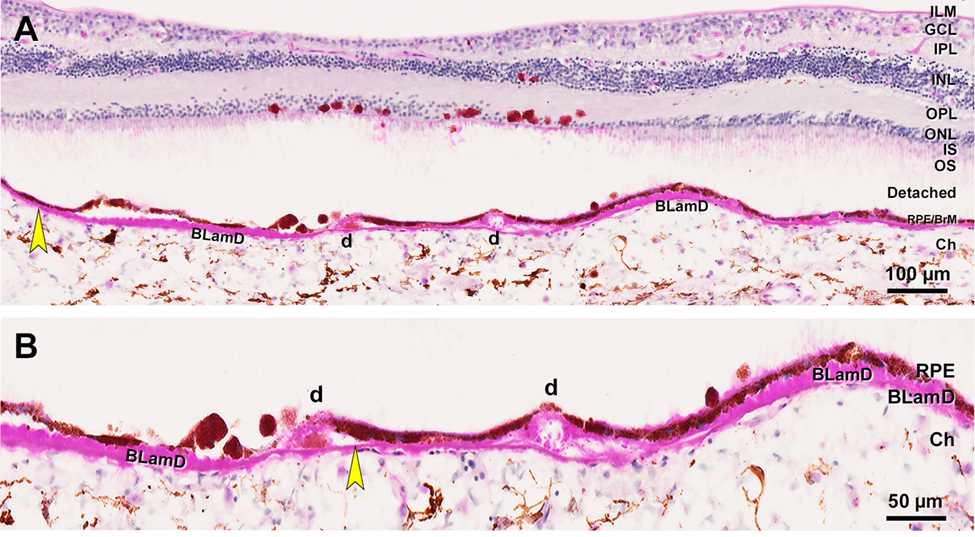Periodic acid Schiff hematoxylin (PASH) staining for human retina
Jamie Allen, Jeff Spraggins, Angela R.S. Kruse, Dongfeng Cao, Jeffrey D. Messinger, David Anderson, Christine A. Curcio
Abstract
Periodic acid Schiff hematoxylin (PASH) staining protocol is adapted from other tissues to identify carbohydrate in human retinal sections in our lab. This method is used for labeling 10-12 µm thick cryosections of human retina, RPE, choroid, and sclera, preserved within 6 hours of death in 4% paraformaldehyde in 0.1 M phosphate buffer, picked up on SuperFrost glass slides, and stored at -80°C. It is intended to be counterstained for nucleic acids in nuclei using modified Harris hematoxylin.
The most common application is for demonstrating glycogen in liver tissue. Positive staining for glycogen is magenta, and nuclei stained by hematoxylin are blue.
This PASH staining protocol is helpful to identify drusen, basal laminar deposits, retinal pigment epithelium (RPE, containing abundant lipofuscin), nuclei, and cell layers of the retina, choroid, and sclera. It is preferable to traditional H&E staining for structures and pathology specific to age related macular degeneration (AMD). It is particularly useful for diagnosis and comparison to clinical retina imaging, especially optical coherence tomography. Since the late 1960s, PASH applied to human AMD specimens was noted to stain an eosinophilic material at the base of the RPE (now known as basal laminar deposit), drusen (the characteristic lesions), and Bruch’s membrane. [1-4]
<1.>Gass JDM. Pathogenesis of disciform detachment of the neuroepithelium. III. Senile disciform macular degeneration. Am. J. Ophthalmol. 1967;63:617-644. PMID 6019308
<2.>Farkas TG, Sylvester V, Archer D, Altona M. The histochemistry of drusen. American Journal of Ophthalmology. 1971;71(6):1206-1215. PMID 4253686
<3.>Sarks SH. Ageing and degeneration in the macular region: a clinico-pathological study. Br. J. Ophthalmol. 1976;60(5):324-341. PMID 952802
<4.>Vogt SD, Curcio CA, Wang L, Li C-M, McGwin G, Jr, Medeiros NE, Philp NJ, Kimble JA, Read RW. Retinal pigment epithelial expression of complement regulator CD46 is altered early in the course of geographic atrophy. Exp Eye Res. 2011;93( 4):413-423 PMID 21684273
Steps
PASH Staining
Remove glass slides with human retinal cryosections from -80°C, keep on ice during transfer from freezer to bench.
Put glass slides on slide warmer (Fisher, Cat# 120594) at 37°C overnight to dehydrate.
Label slides with PASH, date, and additional relevant information.
Hydrate slides with de-ionized (DI) water for 0h 5m 0s
Incubate with 0.5% Periodic Acid from kit for 0h 5m 0s
Rinse DI water for 0h 5m 0s
Incubate with Schiff Reagent from kit for 0h 15m 0s
Rinse with DI water for 0h 10m 0s
Incubate with Harris Hematoxylin from kit for 0h 5m 0s
Rinse with DI water for 0h 5m 0s
Quick dip in 0.5% Acid Alcohol from kit (or 0h 0m 20s)
Rinse with DI water for 0h 5m 0s
Quick 2 dips in Bluing solution of 1% Lithium Carbonate (or 0h 0m 40s)
Rinse with DI water for 0h 5m 0s
Dehydrate using the following series:
75% ethanol 0h 5m 0s
75% ethanol 0h 5m 0s
85% ethanol 0h 5m 0s
85% ethanol 0h 5m 0s
95% ethanol 0h 5m 0s
95% ethanol 0h 5m 0s
100% ethanol 0h 5m 0s
100% ethanol 0h 5m 0s
Xylenes 0h 5m 0s
Xylenes 0h 5m 0s
Mount with Permount (EMS, cat#17986-01) and air dry in hood for overnight.
Image using Virtual Slide System (OLYMPUS, Japan) using 20x, 40, and 60x objectives.
Save images as tiff files with clear labeling: Eye ID/L, R_Age/Gender_Slide #_Dye_magnification (e.g.: 1234567L_97F_050_PASH).

![Figure 2. Periodic acid Schiff hematoxylin (PASH) staining lipofuscin in cone photoreceptors of human retina. Yellow arrowhead, Bruch’s membrane (BrM); cyan arrowhead, cone lipofuscin; scale bars labels for each panel. (A) PASH staining reveals the structure of human retina by each layer. (B) Higher magnification shows lipofuscin in the myoid part of cone inner segments and a few in the ONL. These organelles are found in aged normal and AMD eyes [5]. ILM, internal limiting membrane; GCL, Ganglion cell layer; IPL, inner plexiform layer; INL, inner nuclear layer; OPL, outer plexiform layer; IS, inner segments of photoreceptors; OS, outer segments of photoreceptors; Detached, artifact detached between retina and RPE-BrM-Choroid; RPE, retinal pigment epithelium; BrM, Bruch’s membrane; Ch, choroid. Image: 1234567L-97F-043-PASH-40x5.Echols BS, Clark ME, Swain TA, Chen L, Kar D, Zhang Y, Sloan KR, McGwin Jr G, Singireddy R, Mays C, Kilpatrick D, Crosson JN, Owsley C, Curcio CA. Hyperreflective foci and specks are associated with delayed rod-mediated dark adaptation in non-neovascular age-related macular degeneration. Ophthalmology Retina. 2020;4(11):1059-1068. PMID 32389889 Figure 2. Periodic acid Schiff hematoxylin (PASH) staining lipofuscin in cone photoreceptors of human retina. Yellow arrowhead, Bruch’s membrane (BrM); cyan arrowhead, cone lipofuscin; scale bars labels for each panel. (A) PASH staining reveals the structure of human retina by each layer. (B) Higher magnification shows lipofuscin in the myoid part of cone inner segments and a few in the ONL. These organelles are found in aged normal and AMD eyes [5]. ILM, internal limiting membrane; GCL, Ganglion cell layer; IPL, inner plexiform layer; INL, inner nuclear layer; OPL, outer plexiform layer; IS, inner segments of photoreceptors; OS, outer segments of photoreceptors; Detached, artifact detached between retina and RPE-BrM-Choroid; RPE, retinal pigment epithelium; BrM, Bruch’s membrane; Ch, choroid. Image: 1234567L-97F-043-PASH-40x5.Echols BS, Clark ME, Swain TA, Chen L, Kar D, Zhang Y, Sloan KR, McGwin Jr G, Singireddy R, Mays C, Kilpatrick D, Crosson JN, Owsley C, Curcio CA. Hyperreflective foci and specks are associated with delayed rod-mediated dark adaptation in non-neovascular age-related macular degeneration. Ophthalmology Retina. 2020;4(11):1059-1068. PMID 32389889](https://static.yanyin.tech/literature_test/protocol_io_true/protocols.io.n2bvj8qzwgk5/km27bh5qf0_update.jpg)

